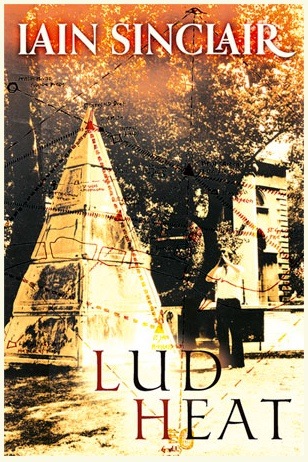Iain Sinclair’s Lud Heat
 Iain Sinclair is best known today as a novelist — though I have always had a preference for his earlier work in poetry. I am therefore very pleased to see that the book I think of as his best, Lud Heat, has just been reissued by Skylight Press, & is thus available again both here in the US & in the UK. This new edition has a preface by Allen Fisher — & I fondly remember the day in 1975 (I think it was) when Allen, Iain & I walked the South London topography of the Hawksmoor churches that are core to this book, with Sinclair as guide & psychic dowser to the mysterious patterns traced by these architectural arrangements. Below, the info from the Skylight Press’ site:
Iain Sinclair is best known today as a novelist — though I have always had a preference for his earlier work in poetry. I am therefore very pleased to see that the book I think of as his best, Lud Heat, has just been reissued by Skylight Press, & is thus available again both here in the US & in the UK. This new edition has a preface by Allen Fisher — & I fondly remember the day in 1975 (I think it was) when Allen, Iain & I walked the South London topography of the Hawksmoor churches that are core to this book, with Sinclair as guide & psychic dowser to the mysterious patterns traced by these architectural arrangements. Below, the info from the Skylight Press’ site:
LUD HEAT
Iain Sinclair
With an introduction by Allen Fisher, and afterword by Michael Moorcock. Illustrations and maps by Brian Catling.Iain Sinclair’s classic early text, Lud Heat, explores mysterious cartographic connections between the six Hawksmoor churches in London. In a unique fusion of prose and poetry, Sinclair invokes the mythic realm of King Lud, who according to legend was one of the founders of London, as well as the notion of psychic ‘heat’ as an enigmatic energy contained in many of its places. The book’s many different voices, including the incantatory whispers of Blake and Pound, combine in an amalgamated shamanic sense that somehow works to transcend time. The transmogrifying intonations and rhythms slowly incorporate new signs, symbols and sigils into the poem that further work on the senses. This was the work that set the ‘psychogeographical’ tone for much of Sinclair’s mature work, as well as inspiring novels like Hawksmoor and Glorianafrom his peers Peter Ackroyd and Michael Moorcock, and Alan Moore’sFrom Hell.
This new re-issue includes the illustrations and photographs from the original 1975 edition, which were absent from some later editions.
“Lud Heat combines researches into the sinister dotted lines which link up the Hawksmoor churches of East London – complete with a very fine diagram displaying the pentacles and triangulations which connect churches to plague pits to the sites of the notorious Whitechapel and Ratclyffe Highway murders – with a broken sequence of breathtakingly lovely modern freeverse lyrics.”
– Jenny Turner, London Review of Books“Lud Heat is ostensibly a narrative of a period of employment in the Parks Department of an East London borough; this temporal location, however, receives less stress than the spatial one with which it intersects: that of the pattern imposed on the townscape by Nicholas Hawksmoor’s churches, potent presences in the poet’s working environment, around which accretes a second temporal dimension, historical and mythological … When Sinclair writes of the modern city that ‘natural & ancient rhythms are perverted in Golgonooza’s architecture’ it is as part of a firmly patterned written structure that we have first of all to take his words. Only thus, sustained by powerful written ligatures, can the arrangement of the poet’s information command any credence as argument.” – Andrew Crozier


 Poasis II: Selected Poems 2000-2024
Poasis II: Selected Poems 2000-2024 “Todesguge/Deathfugue”
“Todesguge/Deathfugue” “Interglacial Narrows (Poems 1915-2021)”
“Interglacial Narrows (Poems 1915-2021)” “Always the Many, Never the One: Conversations In-between, with Florent Toniello”
“Always the Many, Never the One: Conversations In-between, with Florent Toniello” “Conversations in the Pyrenees”
“Conversations in the Pyrenees” “A Voice Full of Cities: The Collected Essays of Robert Kelly.” Edited by Pierre Joris & Peter Cockelbergh
“A Voice Full of Cities: The Collected Essays of Robert Kelly.” Edited by Pierre Joris & Peter Cockelbergh “An American Suite” (Poems) —Inpatient Press
“An American Suite” (Poems) —Inpatient Press “Arabia (not so) Deserta” : Essays on Maghrebi & Mashreqi Writing & Culture
“Arabia (not so) Deserta” : Essays on Maghrebi & Mashreqi Writing & Culture “Barzakh” (Poems 2000-2012)
“Barzakh” (Poems 2000-2012) “Fox-trails, -tales & -trots”
“Fox-trails, -tales & -trots” “The Agony of I.B.” — A play. Editions PHI & TNL 2016
“The Agony of I.B.” — A play. Editions PHI & TNL 2016 “The Book of U / Le livre des cormorans”
“The Book of U / Le livre des cormorans” “Memory Rose Into Threshold Speech: The Collected Earlier Poetry of Paul Celan”
“Memory Rose Into Threshold Speech: The Collected Earlier Poetry of Paul Celan” “Paul Celan, Microliths They Are, Little Stones”
“Paul Celan, Microliths They Are, Little Stones” “Paul Celan: Breathturn into Timestead-The Collected Later Poetry.” Translated & with commentary by Pierre Joris. Farrar, Straus & Giroux
“Paul Celan: Breathturn into Timestead-The Collected Later Poetry.” Translated & with commentary by Pierre Joris. Farrar, Straus & Giroux